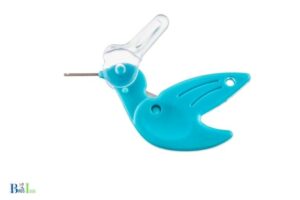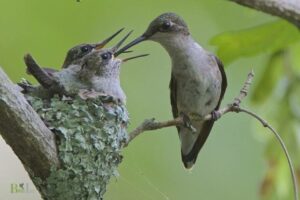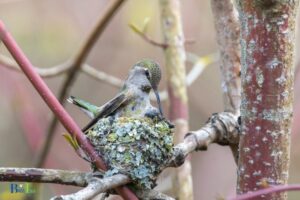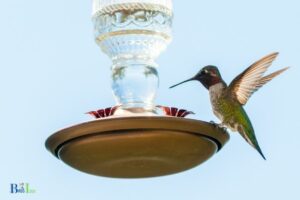How Big Does a Hummingbird Bush Get? Flame Acanthus!
A hummingbird bush, also known as Anisacanthus quadrifidus or Flame Acanthus, typically grows to a size of 3-5 feet tall and 3-4 feet wide.
The hummingbird bush is a perennial shrub native to Texas and Mexico, and it is known for its ability to attract hummingbirds and butterflies due to its tubular, nectar-filled flowers.
This drought-tolerant plant is easy to grow and maintain, making it an ideal choice for gardeners looking to add some color and wildlife to their gardens.
The hummingbird bush is an excellent addition to any garden, not only for its vibrant red, orange, or yellow flowers but also for the wildlife it attracts.
When properly cared for, this low-maintenance plant can thrive in various soil types and is drought-tolerant, making it perfect for regions with limited water resources.
Its relatively compact size allows it to fit seamlessly into gardens of all sizes, offering gardeners a visually appealing and eco-friendly option for their landscaping needs.
Growth Characteristics of a Hummingbird Bush
| Species | Common Name | Average Height | Average Width |
|---|---|---|---|
| Anisacanthus wrightii | Wright’s Desert Honeysuckle | 3-6 ft (0.9-1.8 m) | 3-6 ft (0.9-1.8 m) |
| Dicliptera resupinata | Hummingbird Plant | 2-3 ft (0.6-0.9 m) | 1-2 ft (0.3-0.6 m) |
| Hamelia patens | Firebush, Hummingbird Bush | 6-12 ft (1.8-3.7 m) | 5-8 ft (1.5-2.4 m) |
| Justicia spicigera | Mexican Honeysuckle, Orange Plume | 3-4 ft (0.9-1.2 m) | 3-4 ft (0.9-1.2 m) |
| Erythrina herbacea | Coral Bean, Cherokee Bean | 3-6 ft (0.9-1.8 m) | 3-6 ft (0.9-1.8 m) |
| Zauschneria californica | California Fuchsia, Hummingbird Trumpet | 1-3 ft (0.3-0.9 m) | 2-4 ft (0.6-1.2 m) |
Key Takeaway
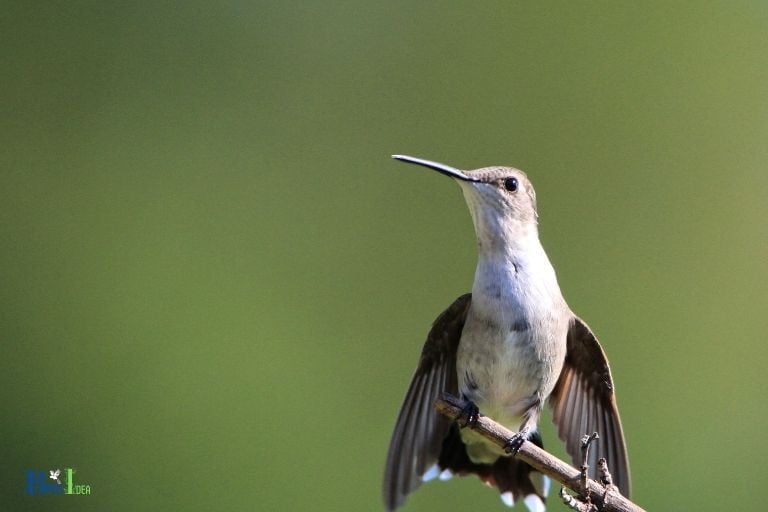
Five Facts About: Hummingbird Bush Growth
Factors Affecting The Size Of A Hummingbird Bush
Hummingbird bushes are beautiful and vibrant in color. Because of their striking appearance, many people choose these plants for their gardens.
They come in various shapes and sizes, meaning that they can be planted in both small and large gardens.
However, several factors can affect the size of a hummingbird bush. Let’s take a look at some of them.
Soil Quality And Type
The soil quality and type greatly affect the growth and size of the hummingbird bush. It is crucial to consider the nutrients available in the soil, so it is essential to ensure that you have quality soil.
Here are some key points on how soil quality and type can affect the growth and size of a hummingbird bush.
- The ph level of the soil influences the growth and survival rate of a hummingbird bush.
- Hummingbirds bushes grow best in well-draining soils that are not waterlogged.
- They do well in sandy, clay or loamy soil types.
Weather Conditions
Weather conditions also play a crucial role in the growth and size of a hummingbird bush. You should consider the climate of your area before planting a hummingbird bush.
Here are some key points on how weather conditions affect the growth and size of hummingbird bushes.
- Hummingbird bushes need mild temperatures to thrive.
- They need moderate rainfall, and their ideal temperature range is between 60-80 degrees fahrenheit.
- If you live in an area with extreme weather conditions, you should avoid planting and may want to consider other suitable options for your garden.
Amount Of Sunlight
The amount of sunlight received by your hummingbird bush is paramount in its growth and will determine its size.
Here are some key points to consider when it comes to the amount of sunlight your hummingbird bush should receive.
- Hummingbird bushes require full sunlight to grow large.
- They may grow if planted in partial shade or full shade, but the size will not be the same as compared to those in full sun.
Watering And Fertilizing Techniques
The right watering and fertilizing techniques are critical in the growth of a hummingbird bush.
Here are some key points to consider when it comes to watering and fertilizing your hummingbird bushes.
- Hummingbird bushes require deep watering once a week.
- Use a quality organic fertilizer once a month during the growing season.
- Avoid over fertilizing or overwatering as this may cause gnarled growth and wilting.
When it comes to the size of a hummingbird bush, specific factors must be considered. Soil quality and type, weather conditions, amount of sunlight, and proper fertilizing techniques affect the growth and size of this beautiful bush.
With these factors in mind, you can grow a big, healthy hummingbird bush that is sure to attract these special birds to your garden.
How Big Does A Hummingbird Bush Get: Understanding The Average Height And Width
Hummingbird bush, also commonly known as flame or fire bush, refers to a tropical plant species widely grown across the world for its beautiful flowers and ability to attract hummingbirds.
Many homeowners love to add hummingbird bushes to their gardens because of their vibrant colors, long-lasting blooms, and ease of care.
However, before planting this beautiful bush, you might have questions regarding its size, including its average height and width.
We will address those concerns under the subheading how big does a hummingbird bush get: understanding the average height and width (###).
Detailed Explanation Of The Range Of The Average Height And Width Of A Mature Hummingbird Bush
Hummingbird bushes are known for their beautiful blooms and vibrant colors, encouraging many homeowners to add them to their gardens.
As the plant grows, the average height and width of a mature hummingbird bush vary, based on several factors like climate and soil conditions, among other circumstances.
Here are the details that you should know:
- On average, a mature hummingbird bush grows to a height of 6-10 feet and attains a similar measurement for its width.
- With enough care and favorable conditions, the plant can grow more extensive than the average measurements.
- However, unfavorable factors can stunt its growth and result in a smaller-sized bush.
Therefore, it is necessary to provide the right nutrients and favorable soil conditions, among other measures, suggested by a gardening specialist, to ensure that the hummingbird bush grows healthily to its maximum potential.
How To Measure The Height And Width Of The Bush
Now that we understand the average height and width of a hummingbird bush, you might be thinking about measuring your own plant. Measuring the height and width of a hummingbird bush can be an essential part of monitoring the plant’s growth and ensuring it remains within the preferred size.
Here are the steps to follow:
- To measure the height, use a measuring tape to determine the distance between the base of the plant and its top edge.
- To measure its width, measure the distance between its opposite edges.
- Take the average and track the numbers to monitor when you need to prune the plant to control its size.
Importance Of Pruning To Control The Size Of The Bush
Despite following all the necessary measures to ensure the hummingbird bush grows healthily, it can outgrow its garden area, causing it to have an adverse effect on your garden’s aesthetic value. To prevent this growth from becoming unmanageable, pruning becomes necessary.
Here are some reasons why pruning is crucial:
- Pruning helps control the size and shape of a hummingbird bush by getting rid of the dead, damaged, or diseased branches.
- It helps maintain the plant’s shape and structure, removing the unwanted branches.
- Pruning ensures that a large, mature plant does not consume all the available nutrients, sunlight, and water.
With the right measures in place, pruning helps keep the hummingbird bush shrubs healthy and improves their overall aesthetic value in the garden.
Hummingbird bushes bring color and vibrancy to any garden, and many homeowners love to plant them.
Understanding the average height and width of a hummingbird bush will help you know what to expect, and by measuring and pruning the plant, you can help keep it healthy and maintaining its desired size.
Which Varieties Of Hummingbird Bush Grow The Biggest
Hummingbird bushes are small shrubs that provide nectar to hummingbirds. They are easy to care for and come in various colors, making them a popular choice for gardens.
If you are thinking of adding a hummingbird bush to your garden, you may be wondering how big they get.
In this blog post, we will explore which varieties of hummingbird bushes grow the biggest.
A Comprehensive List Of The Different Types Of Hummingbird Bushes And Their Growth Characteristics
There are many different types of hummingbird bushes, each with its unique growth characteristics.
Here is a comprehensive list of the most popular hummingbird bushes and their growth habits:
- Anise hyssop: Grows up to 3 feet tall and wide.
- Cardinal flower: Grows up to 4 feet tall and 2 feet wide.
- Coral bells: Grows up to 2 feet tall and wide.
- Firecracker plant: Grows up to 4 feet tall and 3 feet wide.
- Hummingbird mint: Grows up to 3 feet tall and wide.
- Salvia (sage): Grows up to 4 feet tall and wide.
Detailed Description Of The Varieties That Tend To Grow Bigger Than Others
If you want a hummingbird bush that grows big, you should consider getting a firecracker plant or a salvia (sage). These varieties tend to grow bigger than the others on our list.
Here are some detailed descriptions of the varieties:
- Firecracker plant: This variety is also known as cigar plant and grows up to 4 feet tall and 3 feet wide. It has bright red-orange flowers that attract hummingbirds and butterflies to your garden. The plant blooms in the summer and fall and is drought-resistant, making it easy to care for.
- Salvia (sage): Salvia comes in many different colors, including red, purple, and blue. The plants can grow up to 4 feet tall and wide and bloom in the summer and fall. Salvia plants are drought-tolerant, making them a great choice for arid climates.
Tips On How To Choose The Right Variety For A Specific Garden Space
When choosing a hummingbird bush for your garden, you need to consider the space you have available.
Here are some tips on how to choose the right variety for your specific garden space:
- Measure the space: Measure the area where you want to plant the bush to ensure that it has enough room to grow. Hummingbird bushes need enough space to spread out their roots and branches.
- Consider the sun exposure: Different varieties of hummingbird bushes require different amounts of sun exposure. Make sure you choose a variety that is suitable for the amount of sun in your garden.
- Think about the color scheme: Hummingbird bushes come in different colors, so consider the color scheme of your garden when choosing a variety. You may want to choose a variety that complements the colors of other plants in your garden.
If you want a hummingbird bush that grows big, consider getting a firecracker plant or a salvia (sage). Before making your choice, measure the space, consider the sun exposure, and think about the color scheme of your garden.
With these tips, you can choose the perfect hummingbird bush for your garden and enjoy watching hummingbirds visit your yard.
Tips For Growing Large Hummingbird Bushes
Hummingbird bushes are a spectacular addition to any garden. They are effortless to grow and maintain, making them a popular choice for garden enthusiasts.
If you aim to grow a large hummingbird bush that will attract hummingbirds from far and wide, there are a few tips and tricks that you’ll need to follow.
We’ll discuss some of the critical things to keep in mind when growing your hummingbird bush, from preparing the soil to pruning and trimming the plant effectively.
How To Prepare The Soil Before Planting
Preparing the soil before planting is critical to the healthy growth of your hummingbird bush.
Here are some essential tips to consider:
- Ensure the soil is well-draining: Hummingbird bushes thrive in soil that has excellent drainage. If the soil doesn’t drain well, it can cause root rot, which can be detrimental to the plant’s growth.
- Add compost: Adding compost to the soil before planting will provide essential nutrients to the plant that can help it grow vigorously. Compost also enhances the soil’s structure and can improve drainage.
- Test the soil ph: Hummingbird bushes prefer slightly acidic soil with a ph between 5.5 and 6.5. Testing the soil ph will help you determine if any adjustments are necessary.
Techniques For Watering And Fertilizing A Hummingbird Bush
Hummingbird bushes require moderate watering and fertilizing for optimal growth.
Here are some vital techniques to keep in mind:
- Watering: Hummingbird bushes require a moderate amount of water. It’s best to water the plant once a week, ensuring the soil around it is moist but not waterlogged. Avoid overwatering, as this can cause root rot.
- Fertilizing: Fertilize the hummingbird bush during the growing season, approximately every two weeks, using a balanced fertilizer. This will provide the necessary nutrients to support healthy growth.
Importance Of Proper Pruning And Trimming Techniques
Pruning and trimming a hummingbird bush are essential for maintaining its health and maximizing its growth potential.
Here are some crucial tips for proper pruning and trimming:
- Prune during the dormant season: It’s essential to prune the hummingbird bush during the dormant season when the plant isn’t actively growing. This will encourage healthy growth the following season.
- Remove dead and damaged wood: Removing dead and damaged wood will allow the plant to direct its energy to healthy growth and blooming.
- Trim regularly: Regular trimming will help maintain the hummingbird bush’s shape and promote healthy growth.
Magical Watering Habits And Surrounding Plants To Support Its Growth
Finally, there are some fantastical (yet scientifically-supported) beliefs to follow to support the growth of your hummingbird bush truly.
Here are some of them:
- Watering during a full moon: Many gardeners believe that watering plants during a full moon can promote healthy growth. While there’s no scientific evidence for this, it doesn’t hurt to try!
- Planting companions: Planting complementary plants nearby can help support the growth of your hummingbird bush. Some suitable companions include bee balm, salvia, and butterfly weed.
By following these tips, you’ll be well on your way to growing a beautiful, healthy hummingbird bush that hummingbirds will flock to in droves. Happy gardening!
Caring For Large Hummingbird Bushes
Hummingbird bushes are known for providing a delicate elegance to gardens with their vibrant and attractive blooms and for attracting hummingbirds with their sweet nectar.
However, not all hummingbird bushes are of the same size, with some of them growing into large bushy plants that require extra care.
In this post, we will delve into caring for large hummingbird bushes, discussing how to protect the bush from common diseases and pests, the importance of regular maintenance, and tips for overwintering large hummingbird bushes.
How To Protect The Bush From Common Diseases And Pests
Hummingbird bushes are susceptible to several diseases and pests that can affect their health and growth.
Here are some ways to protect them:
- Regularly inspect the plant for signs of illness or pest infestation, including yellowing leaves, wilting, and abnormal growth. Early detection is critical to preventing the spread of disease or pests.
- Use a fungicide or pesticide to control disease or pest problems. Follow the directions on the label to ensure safe and effective use of the product.
- Dispose of any infected plant debris properly to prevent the spread of disease or pests.
- Keep the plant healthy with proper watering, fertilization, and sunlight exposure, as healthy plants are less likely to be affected by pest or disease problems.
Importance Of Regular Maintenance
Regular maintenance is crucial for the healthy growth and longevity of large hummingbird bushes.
Here are some reasons why:
- Pruning and shaping the plant helps to maintain its size and shape, removing any dead or damaged growth, improving airflow, and encouraging new growth.
- Regularly removing spent flowers and seed pods promotes continued blooming and prevents the plant from expending energy on seed production.
- Cleaning up fallen leaves and debris helps prevent the development of diseases and pests.
- Watering and fertilizing the plant on a consistent schedule helps to maintain its health and performance.
Tips For Overwintering Large Hummingbird Bushes
Proper overwintering is essential for large hummingbird bushes to survive the cold and harsh winter months and produce healthy growth in the spring.
Here are some tips:
- Stop fertilizing the plant in late summer to allow it to prepare for dormancy.
- Water the plant well before the first frost to allow it to absorb enough moisture to last through the winter.
- Apply a layer of mulch around the base of the plant to insulate the roots and protect them from freezing.
- For extra protection in extremely cold regions, cover the plant with a frost cloth or burlap.
- In the spring, trim any frost-damaged growth and begin watering and fertilizing the plant again.
By following these tips, you can ensure that your large hummingbird bush remains healthy and thrives in your garden.
FAQ About How Big Does A Hummingbird Bush Get
How Long Does It Take For A Hummingbird Bush To Grow?
What Is The Best Place To Plant A Hummingbird Bush?
How Often Should You Water A Hummingbird Bush?
What Kind Of Soil Does A Hummingbird Bush Need To Grow In?
How Do You Prune A Hummingbird Bush?
Conclusion
After exploring the world of hummingbird bushes, it’s clear to see why they are a popular choice among gardeners and bird enthusiasts alike.
With their unique ability to attract hummingbirds, they bring a lively energy to any outdoor space.
From the various sizes and colors to the different growth patterns, there is a hummingbird bush for every garden.
While the maturity and size of a hummingbird bush can vary based on the specific species and growing conditions, it’s safe to say that most will reach a height and width of up to 6 feet.
As with any plant, proper care and maintenance are essential for a healthy and thriving hummingbird bush.
With a little love, attention, and patience, anyone can enjoy the beauty and charm of these delightful shrubs.
So, whether you’re a seasoned gardener or just starting, a hummingbird bush is a smart and stylish addition to any outdoor space.

